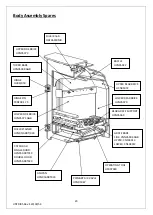
17
JINTDI05 Rev E 20/04/54
L
IGHTING THE
A
PPLIANCE
First, load the fire with starting fuel, i.e. paper, dry
sticks and/or firelighters in the mode chosen,
either wood or solid mineral fuel. Light the fire at
the base leaving all air controls open. Allow the
fuel to reach a steady glow and build the fire up
gradually. Once you have a good fire established
across the grate bed, further fuel can be added as
required.
L
OADING THE
A
PPLIANCE
With a full load of wood, the stove will need to be
refuelled approximately once every hour and a
half.
Wood can be stacked higher in the stove than
solid mineral fuel but care must be taken that logs
do not touch the baffle.
A
IR
C
ONTROLS
Wood burns most efficiently with the primary air
control in the closed position and the secondary
air control approximately 60% open. Moving the
secondary air control will control the burn rate of
the Stove.
The secondary air control should not be
completely closed unless the primary air lever is
also in the closed position.
Wood burns best on a bed of ash and it is
therefore only necessary to remove surplus ash
from on top of the grate occasionally. Do not let
the ash level under the grate reach above the
primary air inlet. If allowed to build-up, ash will
stifle the airflow through the grate.
Burn only dry, well-seasoned wood, which should
have been cut, split and stacked for at least 12
months, with free air movement around the sides
of the stack to enable it to dry out. Burning wet or
unseasoned wood will create tar deposits in the
stove and chimney and will not produce a
satisfactory heat output.
IMPORTANT!
We cannot stress firmly enough how important it
is to empty the ashpan regularly. Air passing
through the fire bed cools the grate bars.
Distortion or burning out the grate bars is nearly
always caused by ash being allowed to build up to
the underside of the grate.
R
EDUCED
C
OMBUSTION
In order to reduce the combustion of the fire to a
minimum, close the primary air controls, then
close the secondary air slider by moving the
handle all the way to the left. If the controls are
left in this position, the fire will receive the
minimum of air and will die down. If you want to
revive the fire it is recommended that the Primary
Air control is open first and then open the
secondary air slider.
REFUELING
Add the new fuel to the fire and open both air
controls fully to allow flames to establish on the
new fuel. Once the fire is established and the logs
are blackened, set the primary air control to its
closed position and adjust the secondary air to
give the desired heat output.
Never leave the stove unattended until you are
certain that the flames are fully established.
Avoid refuelling on to a low fire bed as this may
cause excessive smoke emission. Ensure there are
sufficient embers to ignite the new fuel rapidly.
Alternatively add some more kindling before
adding larger pieces of firewood. Do not add
firewood above the level of the tertiary air inlets
on the sides of the stove. Exceeding this amount
can result in the production of excessive smoke.
E
XTINGUISHING THE
F
IRE
In order to reduce the rate of combustion, close
the primary air lever and then the secondary air
lever by moving the handles all the way to the left.
If the controls are left in this position, the fire will
be starved of air and go out. If you want to revive
the fire it is recommended that the primary air
control is opened first, then open the secondary
air slider.
WARNING!
The stove will remain
hot
for a considerable time
after the fire has been extinguished
R
ECOMMENDED
F
UELS
Hunter Stoves recommend that wood logs are
burnt in this appliance.
To achieve optimum efficiency, do not exceed a
maximum fuel load of 1.6Kg.
Burn only dry, well-seasoned wood, which should
have been cut, split and stacked for at least 12
months, with free air movement around the sides
of the stack to enable it to dry out.









































